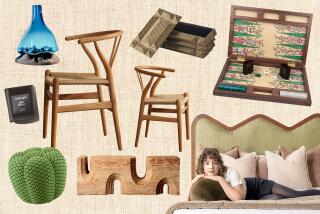French Decor--American Style : Interior design: Furnishings from France are customized to fit the more informal U.S. lifestyle.
- Share via
“On parle Francais” in home decor these days, but with a strong American accent.
In other words, we like French style, but we bend it to accommodate a more informal way of life, particularly in the bedroom, kitchen and family room. Thus, very unlike the French, we put Provencal print sheets on an oversized bed; entertain dinner guests in our “country French” kitchen and hide the television inside an armoire.
In France, the armoire’s place is in the bedroom and its function is to store clothing, says furniture importer Philippe Geisler. If there is a mirror in the room, it’s most likely inside the armoire. In America, the armoire probably will be in the family room--as a cabinet for the entertainment system.
For the American bedroom, an importer of French furniture has to offer a double or triple dresser with a mirror to hang above it if he wants to do much business, says Geisler, president of Tradition France Inc. of Morganton, N.C. And while double beds are most common in France, queen- and king-size beds are essential here.
Once we have our “French” bedroom furniture, we make up the bed in printed sheets with matching dust ruffle, duvet cover and pillow shams. For Americans, you see, there’s nothing more French than Provencal print fabrics or blue and white toile. Yet, French sheets traditionally are white and embellished with family initials and perhaps some embroidered trim, says Pierre Hivert, president of Pierre Deux in New York.
The French use Provencal print fabrics to line their armoire and bureau drawers, closets and cupboards. They also use them as curtains behind the bed and at the window and for cushion covers, tablecloths, napkins and place mats. But never do they use the fabric as bedsheets, Hivert says. (Pierre Deux, however, will accommodate American taste next year with a line of bed sheets in “French” patterns made in America.)
The French kitchen, unlike the American kitchen, is rarely a gathering place for friends. It’s for cooking, with a small table and a couple of chairs in a corner for a quick meal.
“I visited a lovely American home recently. We had all three meals in the kitchen. This would never happen in France,” says Hivert.
To an American, there’s nothing more typically French than the wicker or fruitwood bread holder known in France as a panetiere. In France, a panetiere would be hung in the kitchen and used to store bread and other foods. In the United States, it’s hung on the wall in the family room as decoration.
The family room itself, with its TV set for the family to gather around, is all but unknown in France. The French TV is most likely in the living room or dining room, says Hivert.
“Irrespective of period, French furniture sells best in the United States when it’s been modified to American standards,” Geisler says.
As an example, upholstered easy chairs with exposed wood arms and legs known as bergeres would be covered in velvet or damask back home. They look great to Americans in bright plaids, stripes or contemporary prints. Americans will use rustic iron table bases with more formal glass or marble tops. The French would keep it authentic with well-worn wood.
“A standard cherry finish sells in France because it looks new,” says Geisler. “In the United States, painted and distressed finishes sell well because they look old.”
Geisler predicts that French beds with cane and upholstered headboards will overtake the sleigh beds and paneled headboards so popular in the United States now. Emerging directions are the directoire and empire styles of the 19th century, he says. The directoire period began in 1795, influenced by a taste for Greek and Roman antiquities. Woodwork was often painted in gold and gaudy colors. The Empire period, which began in 1804, saw the return of a more sober look in square-edged pieces often done in mahogany.
Hivert says the whole concept of Pierre Deux is American rather than French. The New York-based company’s imported accessories, fabric and furniture represent the quintessence of French style to many. But it is a concept that is more American than French because it mixes regions, farm and city, pewter and silver plate. The French would not put a Normandy dining room in a Provencal farmhouse.
“You have to be very attentive to discover the American way of doing things,” says Hivert, a Frenchman. “Americans are more oriented to the functions of the room. Then they think about how to dress it up with warmth.
“In France, we still do things the same way we have been doing them for years.”
Distributed by AP Newsfeatures.
More to Read
Sign up for The Wild
We’ll help you find the best places to hike, bike and run, as well as the perfect silent spots for meditation and yoga.
You may occasionally receive promotional content from the Los Angeles Times.






